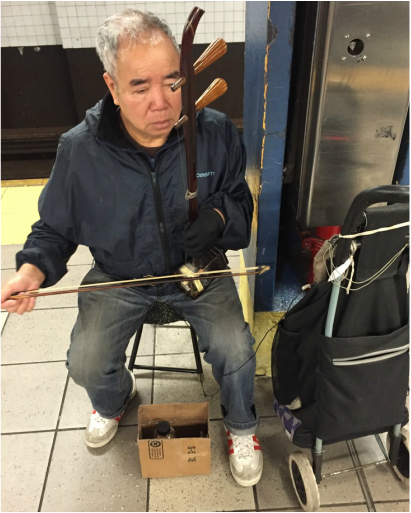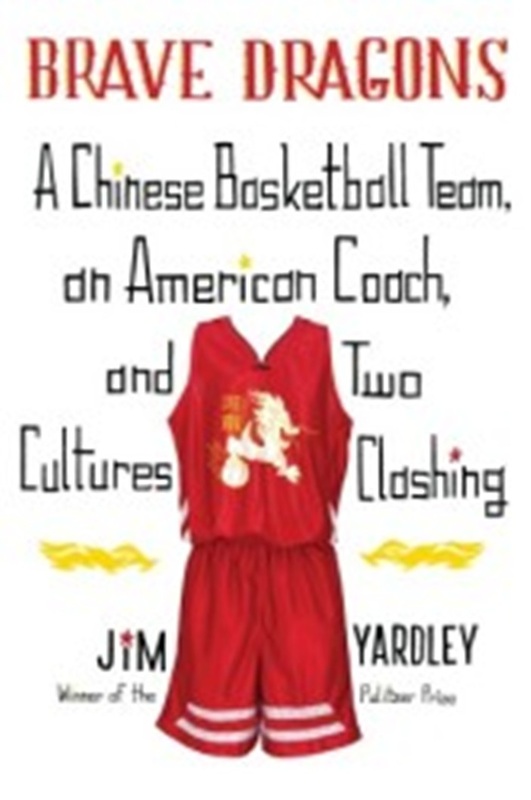|
I look and listen for this man whenever I change subway lines at Roosevelt Ave. in Queens. I often find him midway on the Manhattan-bound platform, facing the E and F trains. In quiet moments I hear the melancholy strains of the erhu, a two-stringed Chinese violin. The chords convey the vastness of China, the long history, the pain, the hope. His own story, I do not know. He keeps his head down, plays to the beat from a mobile speaker. He puts a modest cardboard box between his sneakers. I stand up close. His China is not the neon-and-skyscraper China I encountered at the 2008 Olympics in Beijing, after they bulldozed most of the hutongs, the old neighborhoods. I take a few photos on my iPhone. He does not seem to notice. I drop $5 in the box and say “Xie Xie” -- thanks, in Mandarin. He says, “Thank you.” Then my train arrives. By now, I can envision videos of Jeremy Lin’s amazing adventure of the past two weeks being downloaded from the United States to China in a new form of cultural exchange.
Lin is the Chinese-American basketball point guard from Palo Alto and Harvard who has scored 20 points in five straight games after nearly being cut from this erratic franchise. His foray against the Lakers and other teams would do wonders for the self-image of home-grown Chinese professionals, who do not believe they have the psyche or the soma to compete against Americans, even the discarded Yanks who wash up in the Chinese league. This confession of inadequacy is one of the many powerful points of one of the best books I have read about contemporary China – Brave Dragons: A Chinese Basketball Team, an American Coach, and Two Cultures Clashing by Jim Yardley, just published by Knopf. Confession: I know and admire Yardley, a colleague from The New York Times, formerly posted in Beijing, now in New Delhi. In 2008, Yardley caught up with Bob Weiss, a lifer player and coach in the National Basketball Association who, on a bucket-list kind of whim, had accepted a job coaching the pro team in Shanxi, a marginal team in the coal region of China. As it happens, Weiss wound up working with a Steinbrennerian character named Boss Wang, who treated him the way the American Boss used to treat Billy Martin – you’re up, you’re down, you’re in, you’re out. Weiss’ patience and curiosity kept him in this grim city, working for a tyrant, and opened up space and time for Yardley to meet itinerant Nigerian, Taiwanese, American, Kazakh and Chinese hoopsters. Eventually, the Chinese professionals grew to trust the Mandarin-comfortable Yardley, providing insights into their souls. “As we all know, Asian players are not as capable as players elsewhere.” This was the sentiment not of an outsider but of Liu Tie, a lanky former player who was often ordered by Boss Wang to coach the Brave Dragons instead of Weiss. Liu’s volunteered observation stunned Yardley, who writes that their dialogue “would run roughshod over political correctness parameters in the United States.” But Liu stuck to his beliefs: “We know we Chinese players are different than African American players. They are more physically gifted. We are not. But we believe that by working harder, bit by bit, it’s like water dripping into a cup. Over time, you finally achieve a full cup.” Many of the Chinese players exhibit deference when they see the skills of Donta Smith or Bonzi Wells, two Yanks who pass through, and they watch the admirable work habits of Olumide Oyedeji, a selfless Nigerian center who has passed through the N.B.A. But what they lack, just about everybody agrees, is the individualistic gall to “take it to the rack and stick it,” in the immortal words of Benny Anders, circa 1984, once a promising flash with the University of Houston. Since the international “take-it-to-the-rack” gap is freely admitted by Chinese pro players in Yardley’s book, the solution would seem to be a communal viewing of the recent rampages by their soul brother from California. Lin has played with schoolyard abandon and Ivy League intelligence in reviving a Knicks team that was going nowhere with its solipsistic superstars, Anthony and Stoudemire. So the question for the Knicks now is not how Lin is going to co-adjust with them, but rather how they are going to co-adjust to him. Lin has been penetrating on the best in the game, like Kobe Bryant and Pau Gasol of the Lakers, and if they shut him down, he kicks the ball to somebody else. This discipline is unheard of these days, in an age of N.B.A. players “who shoot when they should pass and pass when they should shoot,” in the caustic words of former Knick coach, Jeff Van Gundy. The fault is not in the genes or the hearts of the Chinese players; their coaches and bosses need to let the game evolve beyond ideology, into art with a purpose. On every level, Yardley’s book is a treat. Like so many of the best recent books on China, he takes us places we are not likely to be going, even as tourists. He takes us to the gyms and arenas as well as the hotels and restaurants and train stations of modern China. He lets us see China through the eyes of not-at-all-ugly Americans like Bob and Tracy Weiss, as they explore a new land. Yardley has the same empathy for Chinese working people as he does for an itinerant player from Kentucky or a failing point guard from Taiwan. For years I have thought that the ultimate book on Chinese basketball was Operation Yao Ming The Chinese Sports Empire, American Big Business, and the Making of an NBA Superstar, by my friend Brook Larmer, published by Gotham Books in 2005. Now it’s a tie. To prepare for covering the Olympics in Beijing in 2008, I read a dozen terrific books, including China Wakes: The Struggle for the Soul of a Rising Power by Nicholas D. Kristof and Sheryl WuDunn, Random House, 1995; River Town: Two Years on the Yangtze, by Peter Hessler, HarperCollins, 2001; and Oracle Bones, A Journey Between China’s Past and Present, by Peter Hessler, by HarperCollins in 2006. Yardley’s book on the Brave Dragons joins them. And the commerce goes both ways – Jeremy Lin videos are surely winging their way electronically to China, to show the next generation: dudes, you can do this. |
Categories
All
|











